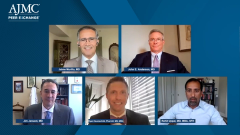
Cost-Saving Strategies Through PCP-Prescribed Therapies in HF
Dr Murillo navigates cost-saving strategies for heart failure treatment by emphasizing collaborative care between specialists and frontline primacy care teams.
Episodes in this series

Ryan Haumschild, PharmD, MS, MBA: Dr Murillo, when we think about people prescribing these therapies earlier on—often primary care providers because there aren’t enough specialists to go around for everybody—how do we incorporate best practices? What are some of the cost savings you think managed care executives will see based on everyone prescribing these agents more appropriately? Do you see decreases in readmissions? Do you see other reductions in total cost of care? I’m curious about your thoughts.
Jaime Murillo, MD: The obvious answer is yes. In randomized clinical trials and, interestingly enough, some subgroups, we’ve done some analyses where we see an even bigger effect. Who will benefit best from what? That’s still a future opportunity. From the private care physician standpoint, we have seen some significant efforts if we talk about managed care in the ACOs [accountable care organizations]. ACOs tend to have more of the team dedicated to identifying patients at risk and making sure the transition from hospitalizations is more adequate, that those physicians are in quicker contact with the patients after leaving hospitals, that they get cared for, and that they have guideline-directed medical therapy. Because they realize that there’s a clear savings opportunity from that standpoint. That’s why I was referring to the opportunity to engage in a more of a collaboration with the specialist.
As a cardiologist, I remember seeing many patients in the office whom I thought I could have solved with a phone call. Wouldn’t it be great if the primary care physician or the hospitalist, as Dr [Rohit] Uppal can tell you, could grab the phone and ask, “What do you think about this patient?” You can take care of more people that way. I’m telling you these stories for more providers to start thinking about: Can we together get to a system where there’s more value-based care? Because that’s the future. Then we don’t have to worry about the cost of medications, whether that’s going to be enough.
Patients with heart failure aren’t well served when we use what I used to call the Walmart approach: “What was the medication that costs the least? That’s what we’re going to start them on.” Dr [Jim] Januzzi likes to start those patients on sacubitril/valsartan. There are groups who benefit from starting on those, probably most of them. Or SGLT2s. But most people say, “Only beta-blockers and MRAs [mineralocorticoid receptor antagonists], because that’s all we can afford.” But if you’re in an environment where there’s more of a team approach, it isn’t about how much you’re billed for a visit or a procedure. It’s about whether this person in front of me is going to be healthier in 6 to 12 months. The patient gets better, but also the total cost of care will be lower.
Transcript edited for clarity.
Newsletter
Stay ahead of policy, cost, and value—subscribe to AJMC for expert insights at the intersection of clinical care and health economics.










































